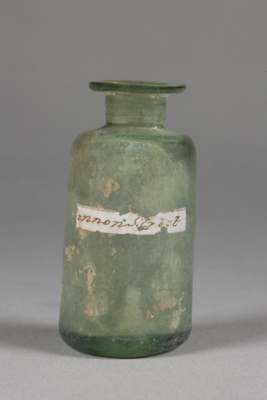< Collection search
< Collection highlights
From:UC Teece Museum of Classical Antiquities
Name/TitleGlass Vial
About this objectA straight-sided flask of pale green translucent glass, the vial is well made with very few bubbles. The vertical neck has an out-turned lip. It appears to date to the second century CE and is reported to have been found in an excavation at Cannon Street, London.
In the second century CE, glass was being mass-produced using molds to shape blown glass. Glassblowing had been invented in the first century CE and produced a much better quality glass that could be used to create vessels with much thinner walls. This gave a more translucent object, and also allowed glassmakers to create a new range of shapes. Colours could be created by adding different compounds, such as adding copper or lead to give a more intense green, or cobalt for an intense blue.
Previously, glassware was made by casting or cutting, similar to how bronze statues were produced. This method not only took longer and was more expensive, it also resulted in vessels with much thicker walls, making the pieces heavier, less intricate and less translucent.
Date Madeca. 2nd Century CE
PeriodImperial (Roman)
Place NotesSaid to have been excavated in Cannon Street, London, England.
Medium and MaterialsGlass
Style and IconographyRoman
Style and IconographyRomano-British
TechniqueGlassblowing
TechniqueMold-blown glass
MeasurementsHeight 69mm; Diameter 35mm (towards base)
Subject and Association KeywordsCosmetics
Subject and Association KeywordsPersonal beauty
Named CollectionThe James Logie Memorial Collection, University of Canterbury, New Zealand
Credit LineDonated by the Nicholson Museum, University of Sydney, through Honorary Curator A.D. Trendall, 1953.
Object TypeStorage Vessels
Object number30.53
Copyright LicenceAll rights reserved
